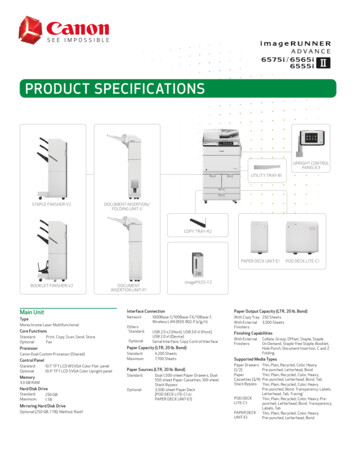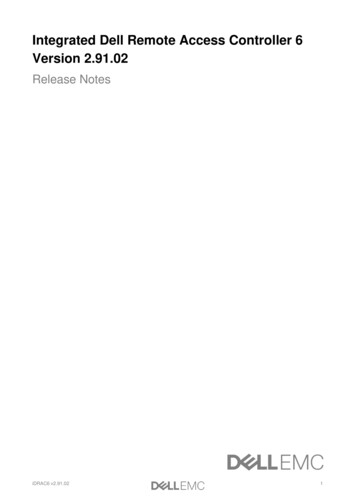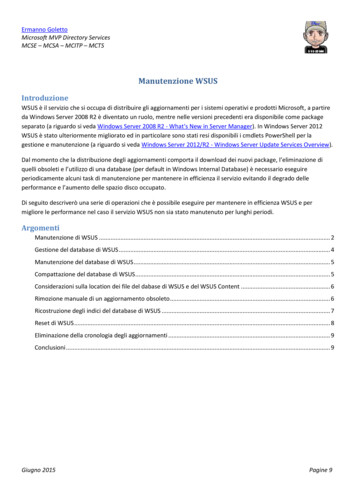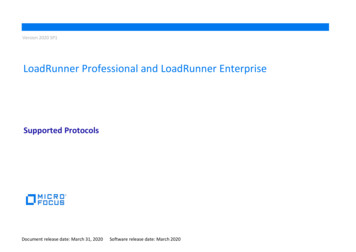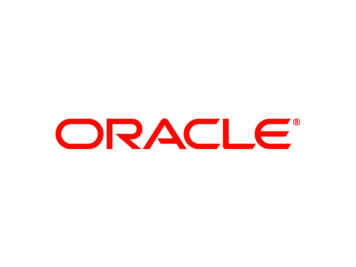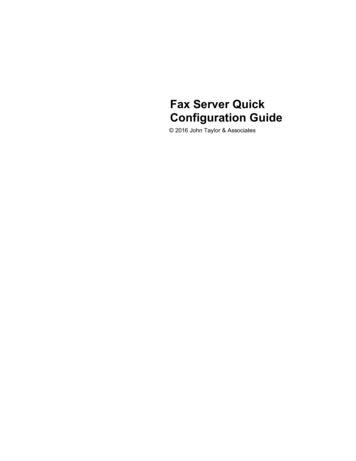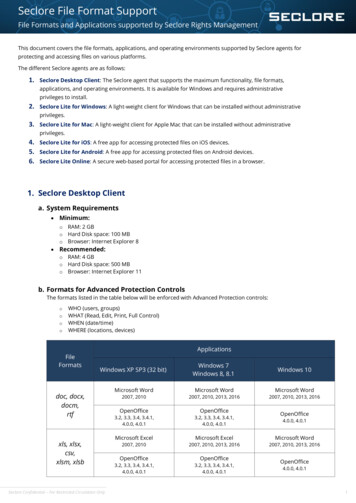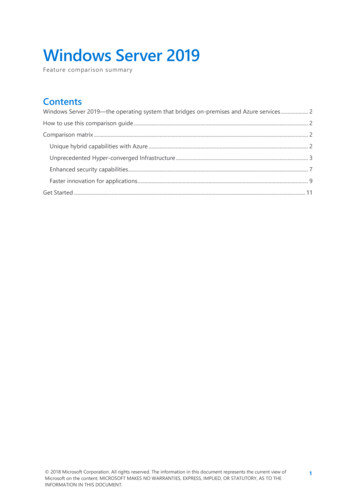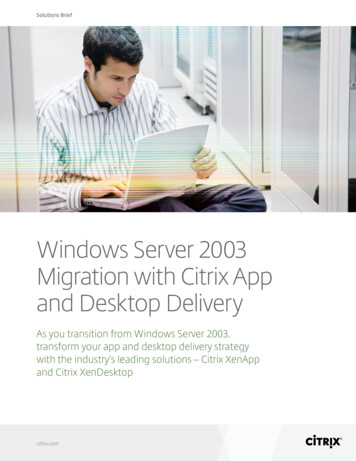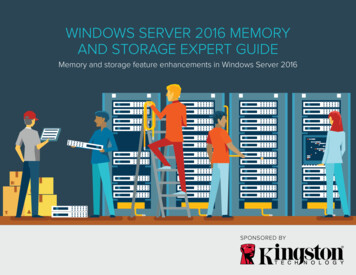
Transcription
WINDOWS SERVER 2016 MEMORYAND STORAGE EXPERT GUIDEMemory and storage feature enhancements in Windows Server 2016SPONSORED BY
TABLE OF CONTENTSIntroduction3Introducing Windows Server 20164Key Memory Feature5Key Storage Features6Putting All the Pieces Together11
INTRODUCTIONAs the data center has evolved, technologies have emerged to helpIT professionals worry less about the underlying hardware theirservices rely on.For example, virtualization has largely abstracted away the hardwarelayer, giving Windows administrators a great deal of control andflexibility in the software-based hypervisor layer. As a result ofvirtualization utilizing previously unused compute and memorycapacity, data center density and efficiency have improved greatlyin the recent past.Lately, we’ve also seen an IT trend toward the convergence of storage, networking and compute resources in the software-defineddata center, where these once largely separate components havebecome more tightly integrated. They now work together morecohesively than in the traditional model, which had more separate,siloed components.With this evolution in mind, Microsoft Windows Server 2016 wasdeveloped to continue this trend by introducing features and improvements that enable administrators to do even more with less.Microsoft’s latest server OS helps IT move further away from a modelof individual physical servers running single applications and towarda more flexible, distributed data center platform. One that allowsfor the automation of storage, memory, compute, and networkingresources and for workloads to move seamlessly between serversor geographical locations, depending on demand.Windows Server 2016 offers enhancements in the areas of virtualization, software-defined storage and networking, security, andmanagement. In addition, Windows Server 2016 brings new featuresto the table such as Windows Server Containers, Nano Server, andStorage Replica. The OS also greatly improves upon features likeStorage Spaces Direct, Storage QoS (quality of service), memoryruntime resize, and more.This white paper will introduce several important Microsoft serverOS storage and memory enhancements that give Windows administrators access to advanced functionality to help IT departmentssave money, thanks to cost-saving new features that once existedonly in specialized hardware. Now they’re available to everyone viaOS, enabling IT professionals to get maximum return on investmentout of the hardware they already have—and to effectively budgetfor future needs.INTRODUCTION3
INTRODUCING WINDOWS SERVER 2016While Windows Server 2016 offers a lot more functionality, it has thesame minimum requirements and upper limits as its predecessor.Staying with these same limits isn’t a big deal because most companies would be hard pressed to find a single application that exceedsany of these maximums.Windows Server 2016 Minimum Requirements 1.4 GHz 64-bit processor 512 MB RAM 32 GB disk space Gigabit (10/100/1000baseT) Ethernet adapterWindows Server 2016 Maximum Supported Memory and VM Limits 4 TB max RAM per server host Up to 1,024 VMs per host 64 vCPU per VM Up to 1 TB RAM per VM 320 LP per host (with Hyper-V enabled, 640 if it’s not) 64 TB VHDX (virtual hard disk used with Hyper-V)For IT professionals considering an upgrade to Windows Server2016, it’s important to understand the new capabilities in order tofully take advantage of its features and make an informed decision—as well as to get the best return on OS investment.Windows Server 2016 offers enhancements in the areas of virtualization,software-defined storage and networking, security, and management.INTRODUCING WINDOWS SERVER 20164
KEY MEMORY FEATUREVM RUNTIME RESIZETo keep reboots to a minimum, a new feature on Windows Server2016 hosts known as Runtime Resize will allow administrators toincrease or decrease memory allocated to a virtual machine withoutany VM downtime, even if Dynamic Memory is disabled.Runtime Resize provides hot add and removes memory capabilitiesfor virtual machines and works on both Generation 1 and Generation2 VMs (which require a guest OS newer than Windows Server 2012or Windows 8). There are a couple of limits: The memory allocated toa running VM can’t be decreased to a level below current demand orincreased to a level higher than available physical system memory.To change the amount of static memory allocated to a VM, youcan go into the virtual machine settings and change the amountof “Startup RAM” associated with the VM.Speaking of Dynamic Memory, just as in previous versions of the OS(starting with Windows Server 2008 R2 SP1), this feature enables aminimum and maximum amount of memory to be specified for indivi-dual VMs, and this memory allocation intelligently scales as demandincreases or decreases. This can go a long way toward ensuringmemory resources are used efficiently. As in Window Server 2012/R2versions, in Windows Server 2016 you can increase the minimumand maximum limits on Dynamic Memory while the VM is running.As a side note, starting in Windows Server 2016 you can also hot addor remove virtual network interface cards (NICs) from a VM withoutthe need to reboot. This feature is on Generation 2 VMs only, andworks with supported Windows or Linux OSes.Note that the features mentioned above apply to Hyper-V virtualmachines. Depending on hardware vendor support, Windows ServerEnterprise and Data Center editions (starting with Windows Server2003 SP1) also support hot-add of physical memory. This allowsmemory to be added to a running operating system without requiringany application downtime or for the physical system to be shut down.KEY MEMORY FEATURE5
KEY STORAGE FEATURESSTORAGE SPACES DIRECTKeeping within the theme of doing more with less, an important storage feature in Windows Server 2016 is Storage Spaces Direct, whichallows IT admins to build a scale-out, redundant, shared storagesystem using inexpensive, commodity “just a bunch of disk” (JBOD)arrays or commodity servers with local internal server storage, or acombination of both.With Storage Spaces Direct, instead of having intelligence that enables advanced storage functionality located in a relatively expensivephysical storage controller as part of a SAN array, this logic residesin the OS. Thanks to Storage Spaces Direct, Windows Server 2016can provide a highly available storage system at a much lower costusing hardware organizations probably already have. In other words,Windows Server 2016 gives IT pros and users access to fully replicated storage that’s redundant with full parity, all on standard x86commodity servers and storage that’s been transformed throughsoftware into a high-performance, redundant infrastructure (leadingsome to use the term “virtual SAN” when referring to the class ofsimilar technologies).Thanks to Storage Spaces Direct, Windows Server 2016 can provide a highly availablestorage system at a much lower cost using hardware organizations probably already have.KEY STORAGE FEATURES6
Storage Spaces Direct scale-out clusters provide the equivalentof RAID across servers, with volumes accessed as a file share tiedtogether through the SMB3 network infrastructure with the benefitof access control list (ACL) permissions. This makes it easy to assignLUNs to servers via permissions, simplifying enterprise storage. Withthis new technology, there might be less need for expensive external storage for many use cases, and IT professionals don’t need tobe storage experts or have much experience with SANs, iSCSI, orFibre Channel switches.Storage Spaces DirectStorage Spaces Direct requires a minimum of four storage nodes,and in addition to fault tolerance and high availability, it providestiered storage and deduplication functionality.Storage Spaces Direct can be deployed in a variety of ways rangingfrom completely separated file and Hyper-V clusters and storagearrays, to a fully hyperconverged box where disks, file servers, andhyper-v are all contained within a single node.Tiered Storage SpacesMost frequently accessed datastored on faster SSD drives. Separate file servers, JBOD arrays, and Hyper-V clusters Converged - Disks in scale-out file server cluster workingwith a separate Hyper-V cluster Hyperconverged - Local disks, file server, and Hyper-Vall-in-one server nodeStorage tiering is a very interesting feature of Storage Spaces Directthat enables high storage performance by allowing administratorsto combine a mix of high-performance and high-capacity HDDs andSSDs in a single virtual hard drive (VHD) to meet performance demand from intensive workloads—without spending too much to meetcapacity needs. Windows Server 2016 accomplishes this by runningmore demanding applications on faster flash drives, since storageperformance is often the bottleneck in virtualized environments.Storage Spaces Direct automatically handles tiering based on whichdata is “hot” or most frequently accessed.Storage PoolKEY STORAGE FEATURES7
STORAGE QoSTypes of QoS PoliciesSingle-Instance Resources distributed among VMs Ideal for representing a clustered workload, application or tenant200Multi-instance policies set explicit limits that are the sameacross all the VMs the policy is applied to. For example, ifyou set a multi-instance QoS policy that allocates 200 IOPSto two VMs, they would both get the full 200 IOPs.VM 210050Maximum IOPs 200Multi-Instance All VMs perfrom the same Ideal for creating per-VM performance tiers200150IOPs VM 1100IT admins can set QoS policies across multiple VMs using eitherPowerShell or a GUI. There are two policy types: Single-instance policies divide a predefined number ofIOPS amongst multiple VMs. For example, with a sharedsingle-instance profile for 200 IOPS that’s applied to twoVMs, they might each receive 100 IOPs.100150IOPsRelated to performance, for IT departments that need to ensure thatspecific high priority VMs or services get the resources they need,storage QoS (Quality of Service) enables administrators to granularly manage policies applied to individual VHDs, services or tenants.This new feature in Windows Server 2016 helps eliminate the “noisyneighbor” problem in virtualization in which one greedy VM takesmore than its fair share of resources, here represented by IOPS(input/output operations per second). While this feature was introduced in earnest in Windows Server 2012, it has been significantlyimproved in Windows Server 2016 because QoS policy can nowbe set so the file server and VMs work collaboratively. In previousversions, policies could only be set at the VM level.100200200VM 1VM 250Maximum IOPs 200KEY STORAGE FEATURES8
DEDUPLICATIONAnother storage aspect that’s been enhanced in Windows Server2016 is deduplication. Windows Server 2012 had a limit that encouraged IT professionals to distribute files across multiple volumes witha 10 TB limit and a single job per volume. While it was effective, itwas a bit slow; it could take days to dedupe a large volume.Deduplication is much faster and more flexible in Windows Server2016. The maximum volume size for dedupe has been increased to64 TB, and the dedupe process is now multi-threaded per volume,where all files are optimized in parallel with load balancing to delivera much faster and more seamless process. In certain situations ITdepartments can achieve up to a 93% lower VHD size with deduplication enabled.1Deduplication in Windows Server 2016:CapabilityWindows Server2012 R2Volume sizingTo scale, distributefiles across multiplevolumes no largerthan 10 TBUse any size upto 64 TBOptimization Single job pervolume Multi-threadedper volume Single CPU andsingle I/O queue All files optimizedin parallelWindowsServer 2016 Auto load balancingof input queues andresourcesBackup supportManual configurationper volume and pernode using PowerShellSetting is an integratedusage type through UIor with PowerShellIn certain situations IT departments can achieve upto a 93% lower VHD size with deduplication enabled.1KEY STORAGE FEATURES9
STORAGE REPLICAAnother storage technology to be aware of in Windows Server 2016is Storage Replica, which provides block-level, hardware agnostic,synchronous or asynchronous replication between servers or clusters for disaster recovery, as well as the ability to fail over a clusterbetween sites.IT departments can replicate volumes locally or across differentgeographical locations with stretch clusters; these include nodes indifferent physical locations that are part of the same cluster, yet stillprovide synchronous, high availability.Stretch Cluster A single storage cluster that spans geographies Automatic failover, synchronous replication Storage replica over SMB3 protocolLocation 1Location 2Node 1Node 3Synchronous mode is recommended for those with a fast connection—1 Gbps network or better, which can be a challenge for stretchclusters across long distances. In early tests, stretch clusters werefound to be effective within distances of 30 km or so. On the otherhand, asynchronous replication allows site extension at greaterdistances, although there is an increased possibility of data loss.Storage ReplicationNode 2Node 4KEY STORAGE FEATURES10
PUTTING ALL THE PIECES TOGETHERWindows Server 2016 represents a step toward a more seamlesslyintegrated data center environment where storage, compute, andnetworking resources don’t exist in silos, but instead work togetherseamlessly in a software-defined data center that can also easilyintegrate with the cloud.Windows Server 2016 represents a step toward the more agile, responsive, resilient, high-performance and distributed IT environmentof the future where workloads will be able to easily get the resourcesthey need when they need them, scale to meet demand, migrate tohosts across geographies, or utilize the public cloud.With the new OS, file servers are built with advanced storage technology in mind, data is more redundant and resilient, IT admins havemore control over all components in their environments, and management and automation of the entire server environment is easierthan with previous OSes. Additionally, because all of these featuresare enabled even on standard servers and storage, organizationscan take advantage of advanced functionalities at a much lower costthan before.In the future, with OSes like Windows Server 2016, organizations willbe able to do more with less, worry less about small details, and takea higher-level, holistic perspective instead of getting bogged downby low-level technical details. Who knows what all is possible as theIT and storage technology that was once prohibitively expensivebecomes accessible to everyone.IT admins have more control over all components in their environments, and managementand automation of the entire server environment is easier than with previous OSes.SPONSORED BY1Jamie Hinks, “Microsoft’s stripped down Nano Server is on the way,” techradar.pro, April 9, er-is-on-the-way-1290666PUTTING ALL THE PIECES TOGETHER11
Windows Server 2016 offers enhancements in the areas of virtua-lization, software-defined storage and networking, security, and management. In addition, Windows Server 2016 brings new features to the table such as Windows Server Containers, Nano Server, and Storage Replica. The OS also greatly improves upon features like
